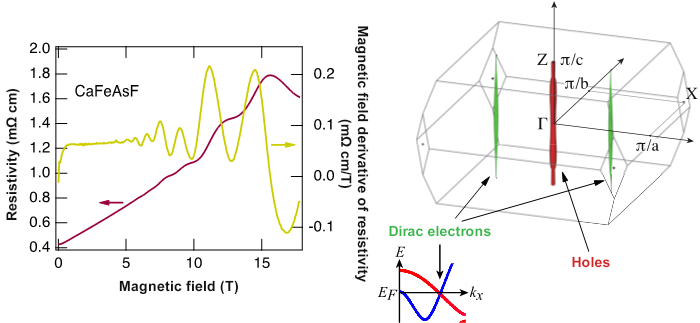Determining the Electronic State of a 1111-Type Compound, a Parent Compound of Iron-Based Superconductors
—Our findings, including the Existence of Dirac Electrons, May Facilitate Investigation of the Origins of Superconductivity in Iron-Based Materials and Development of Novel Devices—
National Institute for Materials Science (NIMS)
Ritsumeikan University
A joint research team consisting of NIMS, Ritsumeikan University and other groups experimentally determined the electronic state of CaFeAsF, a promising parent compound of iron-based superconductors with a high critical temperature. They also confirmed the existence of Dirac electrons—known for their unique properties—in this compound.
(“Fermi surface with Dirac fermions in CaFeAsF determined via quantum oscillation measurements,”
Taichi Terashima, Hishiro T. Hirose, David Graf, Yonghui Ma, Gang Mu, Tao Hu, Katsuhiro Suzuki, Shinya Uji, Hiroaki Ikeda; Phys. Rev. X 8, 011014 (2018) DOI:
10.1103/PhysRevX.8.011014)
Abstract
- A joint research team consisting of NIMS, Ritsumeikan University and other groups experimentally determined the electronic state of CaFeAsF, a promising parent compound of iron-based superconductors with a high critical temperature. They also confirmed the existence of Dirac electrons-known for their unique properties-in this compound. These discoveries are expected to serve as vital fundamental information for investigating the origins of superconductivity in iron-based materials.
- Tokyo Institute of Technology Professor Hideo Hosono and his associates discovered iron-based superconductors in 2008. A great deal of attention has been paid to these superconductors because another iron-based superconductor with a critical temperature 30 degrees higher than that of the initially discovered superconductor was identified within one year of the initial discovery. This indicates the superconductive potential of iron-based materials at unusually high temperatures. Research has been conducted to understand the mechanisms by which superconductivity is generated-vital information in the effort to discover superconductors with even higher critical temperatures. Superconductivity researchers look for new superconductors by substituting elements in parent compounds with other elements. To perform this procedure efficiently, it is crucial to determine the electronic states of parent compounds. A so-called 1111-type iron-based superconductor parent compound exhibits the highest critical temperature of 56 K after appropriate chemical modification. The electronic state of this parent compound had remained undetermined experimentally because of the difficulty of minimizing impurities and defects to synthesize high quality samples of it.
- This joint research team recently succeeded in experimentally determining the detailed Fermi surface structure-the most important electronic state indicator, focusing on the highest energy electrons-of CaFeAsF, a 1111-type parent compound. Specifically, the Chinese team synthesized high-quality single crystals of CaFeAsF and the NIMS and American teams measured quantum oscillations in the compound while subjecting it to extremely low temperatures and strong magnetic fields. The measured Fermi surface consisted of two types of Fermi surface cylinders-electron-like and hole-like-and had an unusually low number of charge carriers, which are responsible for electrical conductivity. These results were consistent with Ritsumeikan University's theoretical predictions. In addition, detailed analysis of the quantum oscillations revealed that the electron-like Fermi surface was composed of a special type of electrons called "Dirac electrons" which travel at high speeds in solids and on which impurities have only a slight influence.
- The determined electronic state of the 1111-type parent compound will serve as vital fundamental information for investigating the origins of superconductivity in iron-based materials. Moreover, confirmation of the existence of Dirac electrons may lead to the development of electronic devices with novel functionalities by exploiting both superconductivity and Dirac electrons.
- This research project was jointly carried out by a research group led by Taichi Terashima (Chief Researcher, Quantum Transport Properties Group, Research Center for Functional Materials, NIMS) and Hiroaki Ikeda (Professor, Ritsumeikan University), the Shanghai Institute of Microsystem and Information Technology, Chinese Academy of Sciences, China and the National High Magnetic Field Laboratory (MagLab), Florida State University, US. The project was funded by JSPS Grants-in-Aid for Scientific Research (Grant Numbers JP17K05556, 17J06088, 16H04021 and 16H01081), the Youth Innovation Promotion Association of the Chinese Academy of Sciences (No. 2015187) and the National Natural Science Foundation of China (No. 11574338). Research conducted at MagLab was funded by the National Science Foundation Cooperative Agreement (No. DMR-1157490) and the state of Florida.
- This study was published in Physical Review X, an online journal of the American Physical Society, on February 1, 2018 (Taichi Terashima, Hishiro T. Hirose, David Graf, Yonghui Ma, Gang Mu, Tao Hu, Katsuhiro Suzuki, Shinya Uji, and Hiroaki Ikeda. Fermi surface with Dirac fermions in CaFeAsF determined via quantum oscillation measurements. Physical Review X. DOI: 10.1103/PhysRevX.8.011014)

(Left) Electrical resistivity (red curve) in CaFeAsF and its magnetic field derivative (yellow curve) at a temperature of 0.03 K. Electrical resistivity fluctuated due to quantum oscillations when exposed to magnetic fields stronger than approximately 5 T. The oscillation is more clearly recognizable with the derivative curve.
(Right) Fermi surfaces determined by band structure calculations. Hole-like (red) and electron-like (green) Fermi surfaces are shown. The graph on the lower left was constructed based on energy band calculations. Dirac electrons found at the point where two energy bands (red and blue curves) intersect formed the Fermi surfaces in green.